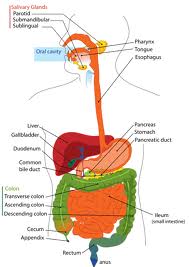Human Body: Overview / Rationale
Fifth grade students are required by Fond du Lac Curriculum Content Standards to have an understanding of the major systems of the human body, including the digestive system. This provides them with a basis for studying this process in other living organisms. It also allows them to understand what’s happening in their own bodies and why things like proper nutrition and exercise are important. The digestive system is particularly interesting to students because of the connection to the food they eat every day.
During this unit, students will be able to identify the major organs that function as part of the digestive system. They will become familiar with the size, shape and location of these organs and will be able to create a life-size representation of their own digestive system on large paper sheets. They will watch a video of a real life digestive system. They will conduct an experiment that illustrates how chewing food aids in digestion.
|
|
The Big Questions!
|
VOCABULARY
Digestive System nutrient protein digestion saliva enzyme mouth esophagus stomach small intestine large intestine (ASSESSMENT) |
Diagram of the System! |
Activities |
Projects |
ExperimentsExperiment One (Click)
|
Summary of the Digestion System
Over the Lips, Through the Gums
Stomach
- When you are chewing your food with your teeth, the food is being crushed up into tiny bits that will be easy for you to swallow. As you are chewing, the food is also being mixed up with saliva from your mouth. The saliva makes the food in your mouth wet and mushy so it is also easy to swallow.
Stomach
- Once your food is pre-digested through chewing, you swallow it and it travels through your esophagus. This is a very long tube that runs from your throat to your stomach. Just like you have saliva in your mouth that helps to break down food you are chewing, there are also juices in your stomach which do the same thing. What happens is, when you swallow your food the juices help to make it into a thick liquid in your stomach like soup.
- Your food isn't done being digested when it goes to your stomach. The next step is going through a long tube that is folded up inside your body called the small intestine. More juices from your liver make the food even more digestible and vitamins and nutrients from the food go into your blood. Blood acts as a carrier for these vitamins and nutrients to transport them throughout your body.
- The next stop is the large intestine. After water is taken from the food and into the blood, all that is left is waste. It is stored at the end of the intestine, inside your rectum.
- This is the opening in your bottom which muscles use when pushing the waste out of your body. If this waste is left inside your body, you may become sick.
- After you are done eating, food can be left in your stomach for up to four hours, and it can take three hours to move through your intestine. It can also remain in your large intestine for up to 36 hours. Meat and milk products are the most easily digestible foods while some fruits and vegetables contain material that is not easily digested. The peas and beans on your dinner plate are only 78 to 83 percent digestible. Although leafy vegetables, certain fruits and bran contains food matter that is not easily digestible, the cellulose and fiber in these foods give bulk to material in your large intestine which makes it easier to sweep out food residue and other matter.

